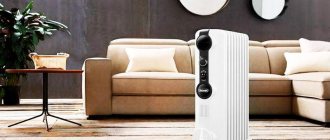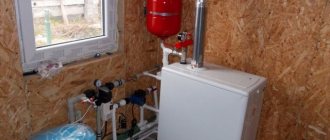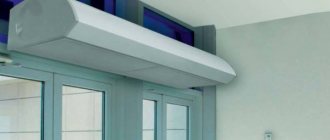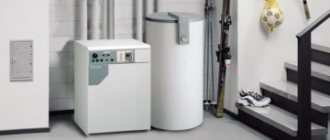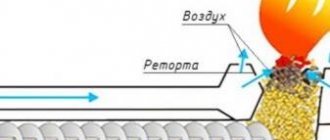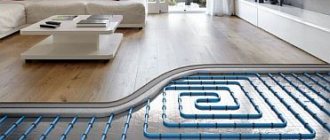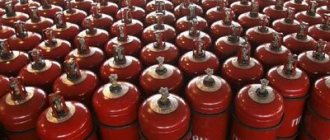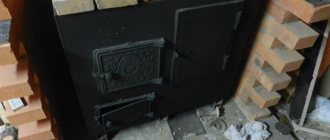- Dimensions
Performance
Operating principle, purpose
At its core, a thermal curtain is a directional fan heater installed on the front door, gate, etc.
The classic design of such a device consists of:
- elongated steel body with an air intake grille;
- turbines of special design;
- heating element;
- nozzles for air outlet.
Thermal curtain design
Almost any model of a modern thermal curtain is equipped with sensors and a thermostat that allow you to monitor and regulate the air temperature in the doorway.
The operating principle of air-thermal curtains is extremely simple. A powerful fan installed inside the device creates a directed high-speed air flow, acting as an “invisible barrier” between the street and the room. This barrier prevents indoor air from escaping and outside air from entering inside.
A correctly selected model of thermal curtain can be used regardless of the season: in winter, the fan heater prevents cold street air from entering the heated room, and in summer, the directed air flow allows you to keep cool air in the room, as well as protect the area from dust and insects from the street.
Operating principle of a thermal curtain
The scope of application of thermal curtains is extensive: they are installed in door and window openings in places with high traffic: in shops, restaurants, airports, train stations, office and warehouse premises, cinemas, clinics, etc. In recent years, the economic effect of such devices has also been appreciated by private homeowners installing thermal curtains over doors in garages and home workshops. With the help of air-thermal curtains, you can easily zone a space. For example, you can “fence off” the hall of a private house from the internal living spaces, without even installing additional doors.
Electricity or hot water as heat source
Basically, electricity acts as a heat source, but there are models where hot water plays this role, it is supplied from the heating system.
Such systems are more difficult to install, but this is compensated by low costs with high equipment power. Typically, such models are used in industrial buildings where there are large open doorways.
The best posts
- Openwork pullovers knitted from angora and mohair with diagrams and descriptions
- How to make a pergola with your own hands
- Aspects of creating a podium in the bathroom
- Chandeliers in the interior of different styles: help in choosing (+130 photos)
- Football crafts 2 in 1 (goal and drink tray)
- What flowers to plant in the flowerbed near the entrance
- Vintage roses from egg trays
- How to tie a scarf around your neck: popular options and methods of tying with photos and videos
Types of thermal curtains
How to choose the right thermal curtain? All existing models can be classified according to installation method and type of coolant.
By installation type
Today there are three types of air-thermal curtains:
- Horizontal. Classic performance. Installed directly above door (window) openings. As a rule, these are small economy class models with a power of up to 5-6 kW;
- Vertical. Install only vertically on the side of the opening. This installation method is chosen when, for one reason or another, horizontal installation is impossible or inconvenient. Today on the climate control equipment market there are designer models of vertical installation, produced in the form of columns;
- Built-in. They are characterized by the fact that the device body is completely hidden under the suspended ceiling. A directed air flow emerges from a nozzle hidden behind a decorative grille.
Horizontal and vertical installation
Recently, on the Russian market of climate control equipment you can find universal thermal curtains that can be installed both horizontally above the opening and vertically on the side of the opening.
By coolant type
Depending on the method of heating the air, all thermal curtains are divided into three groups:
- Gas;
- Water;
- Electrical.
Gas curtain Electric curtain Water curtain
Gas air-heat curtains heat the air by burning propane. This is quite specific equipment that is installed in large enterprises with huge traffic volumes during peak hours. Such systems are not used in rooms with an area of less than 60 m2. They are characterized by high efficiency, cost, and operating costs.
Water air-heat curtains are chosen when there is good access to the hot water supply or heating system. The operating principle of the equipment is as follows: hot water from the system passes through a heat exchanger, which is blown by a turbine. Due to difficulties with the supply and availability of coolant, among water curtains there are no budget class models up to 1 m in length.
The main advantages of such models:
- minimal energy consumption;
- low noise level during operation;
- affordable price;
- long service life;
- high technical characteristics.
Electric thermal curtains are very popular among our compatriots. The equipment can be used in almost any environment: from small windows and doors (models with power up to 2.5 kW) to industrial gates. Main advantages:
- coolant availability;
- simple controls.
The disadvantage is the significant energy consumption during operation.
Curtain for the street: what else should not be forgotten
Air curtains should be installed on the openings on the room side. When installing air curtains vertically on large openings in the absence of protective canopies over the openings, the air curtains can actually be considered as installed on the street. Such air curtains must have IP54 enclosure protection. In addition, when using IP54 air curtains on water, it is necessary to reduce the likelihood of heat exchanger freezing, which causes damage to the air curtain. For this purpose, air curtains use light and sound alarms that are triggered when the temperature of the water in the heat exchanger critically decreases. The air curtain can have an emergency stop function for the air curtain fan motor and an additional pump on its water line. However, it should be remembered that when the air curtain operates on water, no system can provide a complete guarantee against freezing of the heat exchanger. 100% safety of the heat exchanger can be ensured only by using antifreeze or a mixture of a concentration corresponding to the design temperature in the line.
Criteria for choosing thermal curtains
How to choose the right thermal curtain? There are several parameters that you should pay attention to when choosing a model: the required length of the device, air capacity, turbine design, type and power of heating elements, type of installation, method of controlling the air curtain, etc. Let's analyze these parameters in more detail.
Dimensions
The first thing you should pay attention to when choosing an air-heat curtain is the length of the device. Choose a model whose length will completely cover the doorway, without gaps or uncovered areas. The modern market of climate control equipment offers consumers thermal curtains with sizes from 600 to 2000 mm. As a rule, for standard doorways, models with a length of 800-1000 mm are purchased.
For a standard opening, choose a model with a length of 800-1000 mm
Important! When choosing a device based on this parameter, you should remember one significant nuance. To prevent vibration and reduce axle load, manufacturers limited the length of the turbine to 800 mm.
Longer models are assembled according to a different scheme: with two drives at the edges and an electric drive in the center of the device. This design has a weak point in the form of a violation of the integrity of the air flow in the center of the device. That is why, if it is necessary to cover a large opening, it is better to use several devices, up to 800 mm long, placed as close to each other as possible.
Performance
How to choose the required performance of a thermal curtain for the front door? In order for the curtain to reliably cut off the internal space from external influences, it is necessary that the air flow speed be:
- at the exit from the nozzle 8-9 m/s;
- at the bottom point of the doorway (for location above the doors) 2.5-3 m/s.
Refer to the above speed values
If these indicators are lower, then outside air may enter the room. If the performance turns out to be excessively high, the owner will face problems with drafts and reduced efficiency of the air curtain.
Calculations have shown that the optimal performance of a curtain for a doorway 80-100 cm wide and 2-2.2 m high is about 900 m3/hour, power - 6-8 kW (depending on the performance of the device and the area of the room). To obtain more accurate calculations, we recommend using the services of specialists. If you plan to install the curtain inside a vestibule, then choose a model whose power is 15% lower than the optimal or calculated one.
Advice! When choosing a model, be guided by the data stated in the technical documentation. Manufacturers indicate what width and height of the opening a particular model is designed for.
Type of heating elements
Despite the fact that most models belong to the class of heating equipment, their function of heating rooms is secondary. The operation of the heating element is not aimed at maintaining the optimal temperature in the room, but only at partially compensating for heat losses through the door.
Electric air-heat curtains use two types of heating elements:
- heating element. The tubular electric heater is characterized by moderate heating, long service life and safety during operation. The disadvantages include a relatively higher cost;
- Spiral. An open spiral made of nichrome (fechral, kanthal, stainless steel) has a rather short service life, gets very hot, burns oxygen and requires a lot of electricity.
Heating element is more expensive, but safe and durable
Today, some premium models are equipped with a micathermic heater, which allows you to control energy consumption modes.
Control
All models present on the Russian market can be classified according to the control method. There are curtains:
- electronic;
- mechanical;
- with and without remote control.
The most convenient control is the remote control
The simplest devices are equipped with three mechanical buttons:
- Power on/off;
- Start the fan;
- Turning on the heating element.
More technically complex models are equipped with an electronic control system, which makes it possible to:
- Smooth or step adjustment of heating temperature;
- Adjust the rotation speed of the turbine, changing the performance of the device;
- Change the angle of the air flow;
- Set the operating time of the device;
- Control the built-in thermostat.
When choosing the optimal model, it is important to consider how control is implemented. This is necessary to ensure the most comfortable operating conditions for the air-thermal curtain. The best option would be to choose a model with a remote control and electronic control.
Installation method
Depending on the design of the thermal curtain and the dimensions of the room, such equipment can be installed horizontally or vertically. Only a specialist can decide which air-thermal curtain is better in a particular case.
Horizontal installation Vertical installation Recessed air curtain
Installing the device above the door is more economical, correct and convenient in terms of the complexity of installation and subsequent operation. There are cases when horizontal installation is not possible due to the design features of the room. In this case, you should choose a model for installation on the side of the opening.
Built-in models are suitable for rooms in which there is a suspended ceiling or a niche is structurally provided within which this device can be installed.
When choosing a model yourself, it is important to understand that installing the device requires about 50 cm of free space above the opening or on the side of the opening. To connect the device, it is necessary to provide a power line of the required power, the necessary safety and protective devices, and prepare the connection point for the device.
Range
As noted above, the main task of a thermal curtain is to create a dense air flow over the entire area of the opening, which makes it possible to neutralize external influences on the air in the room.
Today, the climate control equipment market offers a range of models, the range of which (height of the “air web” without loss of quality characteristics) varies from 1.5 to 8 meters.
Noise level
To avoid discomfort indoors, you should pay attention to silent models. It should be understood that when installing the device in a residential area, you must be guided by the standards and requirements regulated by SNiP and SanPin. The noise standard for residential premises during the day is 40 dB. If you are faced with the question of how to choose a thermal curtain for installation above the door of a store or office space, then pay attention to models whose upper limit of noise produced will not exceed 55 dB. This indicator is reflected in the technical documentation for the device.
Choose a model with noise emissions below 55 dB
Door opening frequency
This parameter affects the choice of device power. The algorithm is simple: the more often the doors are opened, the more powerful the equipment should be. The correct calculation can be made by using an online calculator or contacting a specialized organization.
Overheat shutdown
Modern models are equipped with a fairly serious set of functions that simplify operation. Everyone determines the issue of functionality based on their needs and financial capabilities. The main thing is that the selected model has a properly implemented safety system, namely, shutdown when overheating. The presence of this function will slightly increase the cost of the model, but will protect it from premature failure, and you from the financial costs of repairing it.
Overheat shutdown is one of the most important functions
Summarizing the above, we have prepared a summary table with recommendations for choosing a thermal curtain model for standard openings.
| Opening size | type of instalation | Supply voltage | Supply voltage |
| 220v | 380v | ||
| 80×210 | Horizontal | Tropic: M-3, A-3 Teplomash: KEV-3p1150e, KEV-4p1150e, KEV-5p1150e, KEV-3p1120e, KEV-4p1120e, KEV-5p1120e, KEV-3p1140e, KEV-4p1140e, KEV-5p1140e Ballu : VNS- 3.000 SB, BHC-3.000 TR Gebo: Ad-306, AN-308 | — |
| Vertical | — | — | |
| 100×220 | Horizontal | Tropic: M-6 Teplomash: KEV-6p2210e Ballu: VNS-6.000 TR Gebo: AN-610 | Tropic: M-6 Teplomash: KEV-6p2210e Ballu: VNS-6.000 TR Gebo: AN-610 |
| Vertical | Teplomash: KEV-6p2220e | Teplomash: KEV-12p3040e, KEV-6p2220e | |
| 100×270 | Horizontal | Teplomash: KEV-6p3230e | Teplomash: KEV-6p3230e |
| Vertical | Teplomash: KEV-6p2220e | Teplomash: KEV-12p3040e, KEV-6p2220e | |
| 120×220 | Horizontal | Tropic: M-6 Teplomash: KEV-6p2210e Ballu: VNS-6.000 TR Gebo: AN-610 | Tropic: M-6 Teplomash: KEV-6p2210e Ballu: VNS-6.000 TR Gebo: AN-610 |
| Vertical | Teplomash: KEV-6p2220e | Teplomash: KEV-12p3040e, KEV-6p2220e | |
| 150×230 | Horizontal | Teplomash: KEV-6p2220e, KEV-6p1260e | Tropic: M-9 Teplomash: KEV-6p2220e, KEV-9p2220e Ballu: BHC-9.000 SR, BHC-9.000 TR Gebo: AN-915 |
| Vertical | Teplomash: KEV-6p2220e | Teplomash: KEV-12p3040e, KEV-6p2220e |
Defining parameters
For a vertical electric heat curtain to work effectively, its length must overlap the size of the doorway by at least 10 cm. When purchasing a horizontal model, if the wall dimensions and budget allow, it is optimal to choose a thermal curtain 25 cm longer than the width of the opening. And one more thing: the height of the flow must be no less than the height of the opening. In this case, the air flow is guaranteed not to let in cold and dirty air from the street.
Formula for calculating the performance of a thermal curtain
The maximum length of electric thermal curtains is 3 meters. If the opening width is larger, it is necessary to install two devices connected to each other and installed close to each other.
ModelPowerInstallation methodPowerOpening width/installation heightHeating areaAir consumptionControlPrice
| Ballu BHC-L15-S09 | 380 V | horizontal | 9 kW | 1500 mm | 90 m | 1050 m3/hour | wired remote control | 200$ |
| Timberk THC WS3 5MS AERO II | 220 V | horizontal | 5 kW | 590 mm | 50 m | 480 m3/hour | without remote control | 130$ |
| Ballu BHC-L08-T03 | 220 V | horizontal | 3 kW | opening height 2500 mm | 30 m | 600 m3/hour | without remote control | 95$ |
| Ballu BHC-L10-S06-M | 220 V | horizontal | 6 kW | 2500*1000 mm | 60 m | 700 m3/hour | wired remote control | 185$ |
| WWQ TZR-6S | 220 V | horizontal | 6 kW | 2200*1110 mm | 60 m | 780 m3/hour | wired remote control | 110$ |
| Tropic K-2 | 220 D | horizontal | 2.5 kW | 2000*390 mm | 130 m3/hour | without remote control | 55$ | |
| NeoClima TZS-915 | 380 V | horizontal | 9 kW | 2500*1500 mm | 90 m | 1140 m3/hour | wired remote control | 200 $ |
| Hyundai H-AT1-50-UI527 | 220 V | horizontal | 5 kW | 2200*800 mm | 50 m | 480 m3/hour | without remote control | 85$ |
The next parameter that can be selected is flow rate or productivity. If we talk about the speed of air flow, then with increasing distance from the curtain, it drops significantly. In most cases, a speed of 2 m/s is sufficient to create a stable elastic barrier. But this is if there is no strong wind blowing through the doors. With constant winds directed into the doorway, the speed should be higher. But a specialist will determine the exact figure, since it is also necessary to take into account the balance of ventilation, temperature differences, etc.
For an electric heat curtain to work effectively, the height/width of the flow must be greater than the opening parameters
You can focus on performance. This parameter immediately describes the characteristic, but from the other side. The required performance depends on the opening height:
- with an opening height of up to 2 m - 850 m³/h per meter of length;
- from 2 to 2.5 m - 1200 m³/h per meter of length;
- from 2.5 to 3 meters - 1800 m³/h and more.
For proper operation, you need to select parameters
In the presence of strong winds the value increases. An electric thermal curtain with higher performance belongs to the class of semi-production or production. They are also called high-pressure. The maximum height (or width) they can cover is 10 meters.
Rating of the best manufacturers of thermal curtains, review of models
Ordinary consumers of this product segment do not always agree with the recommendations of experts. To help you choose the most suitable model, we present to your attention a rating of popular thermal curtains based on real user reviews.
Budget models
| Model | Characteristics |
| Ballu BHC-L06-S03 This model is intended for installation in doorways of apartments, private houses, technical and utility rooms, garages and outbuildings as a heater and energy-saving element. The power of the device is 3 kW. Productivity - 350 m3/hour. The recommended height of horizontal installation is 2.5 m. Equipment: two-stage power adjustment 1.5/3 kW, ventilation function without heating. The price varies from 3.5 to 5 thousand rubles. Advantages:
Flaws:
| |
| Tropic K 6 A popular domestically produced model, which is perfect for installation on standard window openings in private houses and apartments. Installation type: horizontal. Installation options: wall, floor. Power - 6 kW. Productivity - 350 m3/hour. Recommended installation height is up to 2.2 m. Equipment: two-stage power adjustment 3/6 kW. Can work in ventilation mode. The average cost is 6,000 rubles. Advantages:
Disadvantages: no remote control. | |
| Dantex RZ-0609 DDN An excellent, inexpensive and high-performance model designed for installation on the front door. Power - 6 kW. Productivity - 800 m3/hour. Features: metal impellers are used in the turbine design. Equipment: ceramic heating element (Positive Temperature Coefficient), overheating protection, multi-stage flow rate adjustment, remote control. The average cost is 8,000 rubles. Advantages:
No deficiencies found. |
Middle price segment
| Model | Characteristics |
| Frico AD105 Compact and lightweight model, designed for installation above window openings in small retail outlets, pavilions, offices, shops, etc. Power - 4.5 kW. Productivity - 500 m3/hour. Equipment: thermostat, power and flow rate regulator, overheating protection. The noise level does not exceed 50 dB. Features: possibility of installation in a suspended ceiling space. The average cost is 15,000 rubles. Advantages:
The disadvantage is the narrowly focused scope of application. | |
| CLASSIC KS-1003 According to reviews, this model reduces heat loss by up to 80% and ensures the maintenance of a comfortable indoor microclimate. Power - 3 kW. Productivity - 1350 m3/hour. Width - 985 mm. Installation height - 2.5 m. Installation type - horizontal. Equipment: thermostat, power and flow rate regulator, overheating protection, remote control. Features: heating elements with stainless steel fins are used as heating elements. The average cost is 18 thousand rubles. Advantages:
The disadvantage is the high cost of the device. | |
| Ballu BHC-18.500TR A powerful and efficient curtain designed for installation above openings up to 2 m wide and up to 5 m high. The scope of application of this model is extensive: gates of production workshops, hangars, warehouses, terminals, garage complexes, depots, exhibition halls, etc. Power: 20 kW. Productivity - 4000 m3/hour. Installation type: vertical/horizontal. Equipment: thermostat, overheating protection, heating power control, ventilation mode without heating. The average cost is 25,000 rubles. Advantages:
No deficiencies were identified. |
Premium models
| Model | Characteristics |
| Ballu-Machine (PS) BHC-H20T36-PS This model is designed to create an air barrier that prevents street air from entering the room. The product is installed in rooms with opening heights of up to 4.5 meters. Power - 36 kW. Productivity - 5000 m3/hour. Equipment: stepwise adjustment of power and air flow speed, remote control, thermostat. Installation type: universal. Features: spiral fin heating element, external rotor electric motor, solid nozzle. The average cost is 36 thousand rubles. Advantages:
Flaws:
| |
| Artos BARRIER 1500 This model is characterized by high reliability, quality and excellent technical characteristics, allowing installation in industrial, warehouse and retail premises. Power - 0.54 kW, productivity - 9000 m3/hour. Installation height - 6 m. Installation method: vertical/horizontal. Features: the model is equipped with adjustable blinds that allow you to change the direction of air flow. The average cost is 45,000 rubles. Advantages:
The disadvantage is the high cost of the device. | |
| Frico AD-215A High-performance air curtain without heating function is designed for horizontal installation in domestic and industrial premises. Installation type - above doorways, up to 2.5 m high. Capacity - 2100 m3/hour. Features: Thermozone technology allows you to create a low-turbulent air flow with a minimum noise level (43 dB), the ability to install in a suspended ceiling, the ability to adjust the speed and direction of the air flow. The average cost is 65,000 rubles. Advantages:
The disadvantage is the high cost of the device. |
Heating element type
The electric heater of the thermal curtain can be in the form of a spiral or a heating element.
Spiral
An effective but not durable heating element option. Efficiency is achieved due to the strong heating of the wire, and the service life depends on its quality and endurance.
heating element
This heater is more modern than the previous version and has a tubular body filled with quartz sand. There is a spiral running inside it. This device has high heat transfer and a long service life.
Tips for choosing
As a conclusion, we will try to briefly outline the main criteria for choosing an electric air-heat curtain:
- Dimensions are the first thing you should pay attention to. The length of the device must completely cover the width of the opening;
- Performance. To create an effective barrier, the model must pump the required amount of air per unit of time. For standard openings, this value varies from 800 to 1000 m3/hour;
- Installation method. There are models with horizontal and vertical installation options. If there is no possibility for horizontal installation, then pay attention to models with a universal installation type;
- Equipment. Everything here is individual, but some points are worth paying attention to. It would be very nice if the device can operate in fan mode. The presence of a thermostat will make it possible to maintain the set temperature, which has a positive effect on energy savings. Pay attention to the presence of overheating protection and the noise level of the device.
Watch a video about choosing a thermal curtain
Curtain Control
You can control the heat curtain using a remote control, which can be remote or built-in.
The specified equipment must have at least two switches that allow you to turn on the heater and fan. More expensive models have the ability to stepwise regulate the heater power and fan speed.
Article on the topic: How to use wallpaper with trees in the interior, wood pattern
This equipment can be controlled using a remote or built-in control panel. Usually small curtains have built-in control panels, while industrial curtains are controlled remotely, since it will be difficult to reach their buttons.
Some models are additionally equipped with a thermostat, which allows you to turn off the heating elements or the entire equipment when the set temperature in the room is reached.
Industrial models often use limit switches, which allows thermal protection to be turned on only when the door is opened. This saves energy. For ordinary doors, this method of saving is not used, since it takes 5-10 seconds to reach operating parameters, and during this time the doors will already close.
To protect against overheating, almost all models have several degrees of protection: without turning on the fan, the heating element is not connected; when the temperature of the heating element reaches 80-110°C, the power is turned off.
Vertical protection, unlike horizontal protection, is installed on the side of the doorway. It is no different from horizontal, and its height should be at least 3/4 of the height of the opening.
